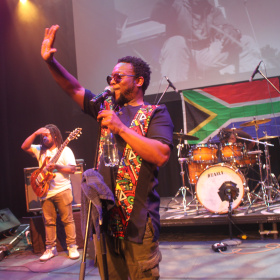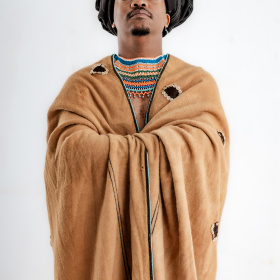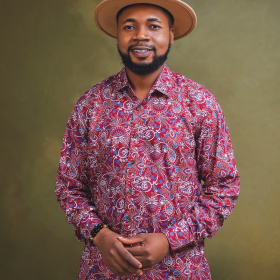The birth of modern Ethiopian music
By Julien Le Gros
Ethiopian music may be the most peculiar and mysterious tradition among African musical cultures. From the 1960s onwards, it has been modernized in remarkable ways. This text provides an overview of modern Ethiopian music.
 Ethiopian artist Mahmoud Ahmed. Photo: www.theartdesk.com
Ethiopian artist Mahmoud Ahmed. Photo: www.theartdesk.com Ethio-jazz pioneer Mulatu Astatke. Photo: www.artfulliving.com.tr
Ethio-jazz pioneer Mulatu Astatke. Photo: www.artfulliving.com.tr Police Ethiopiques. Photo courtesy of Julien Le Gros
Police Ethiopiques. Photo courtesy of Julien Le Gros
Origins
Ethiopian music is characterized by its moods from the time of Aksoum Kingdom back in the 4th century BC. That kingdom had important ties with both the Roman Empire and India.
Wind instruments were introduced to the country at the end of the 19th century under Negus Ménélik, with the arrival of Italian, English and French delegations. By then, music was already strongly linked with politics.
Apart from short Italian occupation by Dictator Mussolini’s troops, from 1935 to 1940, Ethiopia, unlike many other African countries, has never been colonized. This exceptional situation at the scale of the continent explains partially why the Ethiopian melodies music are so peculiar.
During the long reign of Emperor Haile Selassie I, which started in 1930, the governmental and military band, the Imperial Bodyguard Band, was one of the best. Amazingly enough, an Armenian musician, a survivor from the Armenian genocide named Nersès Nalbandian, played a huge part in it. He was recruited by Emperor Selassie in the 1930s and opened a music school in Addis. Nalbandian has trained many of the best musicians of the country. Those musicians were the elite incorporated in the official orchestras, such as Army band, Police band, Haile Selassie Theater band, etc.
That music moved by a free spirit was flirting with rock’n’roll and twist from that era without losing its roots. To better understand that spirit between tradition and modernity, one should listen to ‘Tezeta’ (meaning ‘nostalgia’ in Amharic) by Mahmoud Ahmed. This powerful song digs deep inside the soul of the country.
Swinging Addis
This new music was very popular during the 1960s and 1970s with the azmaribets, the local cabarets from the capital city Addis Ababa. During that time the city was even nicknamed ‘Swinging Addis’. From the Stereo Club to Ebony passing through the Axum Adarash clubs, music was everywhere in the streets with a brand new tinge, due to amplified electric instruments. Without ever losing that distinctive soul and scent from thousands of years back, it is as natural and hypnotic as the famous Ethiopian coffee ceremony.
In 1969, Amha Eshété created his own label, Amha Records, despite the imperial censorship. Meanwhile private orchestras performed in the hotels of Addis, such as Ghion band or Ras Band. A wind of freedom was blowing at the end of Haile Sélassié's reign, but it was brutally stopped by the Revolution of July 1974. The following decade, orchestras were disbanded by the Derg, the regime of Mengestu Haile Mariam. At that time most of the main artists of that music were struggling to survive. "It was not easy during that time,” singer Mahmoud Ahmed reckons. In 1972 singer Getachew Kassa sang an eponymous pop song. Such a masterpiece is also tell-tale of the musical and cultural emancipation the country witnessed in that era. At the time the tune was released with 3000 copies, a major hit at the national level.
Mahmoud Ahmed: The Ethiopian Elvis
Among the wave of modern Ethiopian musicians, the career of Mahmoud Ahmed is one of the most remarkable. The modest shoe shiner from the Gurage tribe has managed, thanks to his talent and strength, to find his way as a musician in Addis Ababa. "I was seated on my shoe box,” the singer recalls. "I was listening to Ethiopian music on Hailé Selassié's radio. There was a program every Tuesday and Thursday. I could listen to the music of Menelik Wesnatchew, Kassa Tessema, Bizunesh Bekele, Tilahun Gessesse. It was a time with an enormous musical creativity. "
Soon an artistic calling grew in that man, with a golden voice and swinging legs inspired by none other than Elvis Presley. “I saw him in a film, " he says. “He was dancing well and I have imitated the way he moved his legs, his way of shaking. "
In 1962 the owner of Arizona Club in Addis hired Mahmoud as a handyman. Then he got the chance to sing for the Imperial Bodyguard Band. It was a great time for Mahmoud: "At that time I could see the emperor many times. We even played at the Palace". In 1974 with the revolution, the orchestra was disbanded. Dictatorship would last until 1991.
Meanwhile, Mahmoud did his best to survive with other bands, such as Ibex band and Roha band. For years he was no longer in the spotlight - until the huge success in 1986 of his hit ‘Ere mela mela’.
In 2015 Mahmoud Ahmed embarked on a world tour with a French group, Badume's Band. This band has been touring with him for more than 10 years, backing other Ethiopian veterans like the great singer Alemayehu Eshete.
Mulatu Astatke: King of Ethio-jazz
Originally born in Jimma, 300km from Addis, Mulatu Astatke had early enough the opportunity to study music abroad. In the 1960s Mulatu had, like Fela Kuti, a very interesting experience of jazz in England that he brilliantly merged with his Ethiopian roots. One of his first LPs, Mulatu of Ethiopia, is representative of that fusion of styles with tracks like ‘Afro Latin Soul’. Mulatu is also the first African to ever graduate from the famous Berklee Music College of Boston in the USA. This western influence and his use of vibraphone in jazz big bands has also contributed to the style invented by Mulatu: Ethio-jazz.
Mulatu defines his music this way: "It is a mélange of different Ethiopian moods. It is based on five notes and 12. You need to combine the 5 against the 12, without losing the initial colour. Ethio-jazz does not resemble any other music. The emotion of that music comes from backward with harmonic structures from thousand years ago. "
In 2005, thanks to the soundtrack of the movie Broken Flowers directed by Jim Jarmursch, the strange music of Mulatu gained a huge popularity. "It gave me an international visibility," he confides. "Even the children of Bob Marley have begun to sample my music. All my concerts were sold out! "
Since then, Ethio-jazz groups have started to spring up like mushrooms in the entire world. However, there is a gap between the international echo of Ethio-jazz and recent Ethiopian music (since 2000) that does not match the standards of the original music from the 1960s and 1970s.
Nevertheless, Ethio-jazz has become one of Ethiopia's ambassador. Still today Ethiopian culture fascinates a lot of people. In his most recent album, Sketches of Ethiopia (World Village, 2013), Mulatu carried out some musical research on his own country. One of his compositions, entitled ‘Gumuz’, refers to this tribe from the north of Ethiopia. "They are musically fascinating - to a point that RnB singer Beyoncé Knowles has worked on choreographies inspired by dances from this area!” Mulatu says.
Mulatu is also trying to modernize the krar, a traditional of 5- or 6-stringed lyre, decorated with fabric and pearls. It is played by Azmaris (traditional musicians) in popular Ethiopian and Eritrean music. Nowadays the krar has been amplified like an electric guitar. "This instrument contributes to the colour of Ethio Jazz,” explains Mulatu. "I mix this traditional instrument with European instruments like saxophone. I try to make it evolve. For the moment it can only play four from the five moods of Ethio-jazz. "
The international rise of Ethiopian music
In 1996 a French lover of the country, Francis Falceto, launched the famous Ethiopiques compilations with the label Buda Musiques. These compilations have played a major role in spreading knowledge of this music to the rest of the world. This music specialist has his own definition of Ethiopian music from the 1960s: "People like Alemayu Eshete, saxophone player Getachew Mekurya, Mahmoud Ahmed... perform Ethiopian modern music , Ethiopian pop."
Today western bands like Antibalas, Souljazz orchestra or Budos Band use elements of Ethiopian music from the 60s. Some are more obivously Ethio-jazz bands themselves, like the French groups Akalé Wubé and Badume's Band or The Heliocentrics from the UK. In addition, international Ethiopian artists like singer Gigi (married to American jazz man Bill Laswell), Krar Collective and the Addis Acoustic Project led by Girum Mezmur are forging new genres of Ethiopian music. Given their international success, we shall continue to hear from Addis for many years to come.
References
- Personal interview with Mahmoud Ahmed in Paris, France in 2014/2015
- Personal interview with Mulatu Astatke in Paris, France in 2014/2015
Further reading
- Falceto, Francis. 2000. ‘Land of Wax and Gold’. In Broughton, S. and M. Ellingham, with McConnachie, J. and Duane, O. (ed.), World Music, Vol. 1: Africa, Europe and the Middle East, p. 480–487. Rough Guides Ltd/Penguin Books.
- Mazzoleni, Florent. 2011. ‘Afro Pop, L'âge d'or des orchestres africains’. Le Castor Astral, February 2011. Available online at http://www.castorastral.com/livre/afro-pop-lage-dor-des-grands-orchestres-africains/
- Falceto, Francis. 2015. ‘Abyssinie Swing, images de la musique éthiopienne moderne’. France Musiques Archive, Carnet de voyage. Available online at http://www.francemusique.fr/emission/carnet-de-voyage/2014-2015/abyssinie-swing-images-de-la-musique-ethiopienne-moderne-06-07-2015-19-00
- Special thanks to Adrien N'Diaye



































Comments
Log in or register to post comments